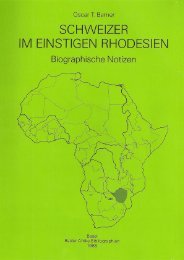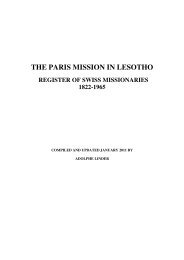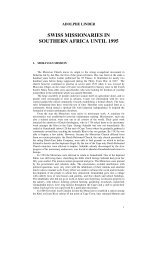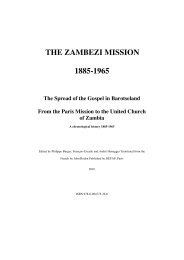THE SWISS IN SOUTHERN AFRICA 1652-1970 - swissroots-za.ch
THE SWISS IN SOUTHERN AFRICA 1652-1970 - swissroots-za.ch
THE SWISS IN SOUTHERN AFRICA 1652-1970 - swissroots-za.ch
Create successful ePaper yourself
Turn your PDF publications into a flip-book with our unique Google optimized e-Paper software.
Jan Saus<strong>ch</strong>e of Rougemont VD bought a farm in the Berg River valley below Paarl,<br />
but hired out his lands on a share crop basis and continued working as blacksmith. He<br />
never married and left no descendants.<br />
Most Swiss freemen took work as farmhands, staying long years with farmers who<br />
treated them well. Some eventually hired part of the farm, the owner receiving as rent<br />
one third of all produce. Thus in 1773 Hendrik Freene of Canton Berne was recorded as<br />
owning 10 head of cattle and 200 sheep, and 1741 Johannes Litseler of Canton Basel<br />
had 32 head of cattle.<br />
TRADESMEN, TEACHERS AND BUS<strong>IN</strong>ESSMEN.<br />
On obtaining burgher status those proficient at a trade would take employment, or, if<br />
they had sufficient enterprise, work for their own account. In 1688 Hans Jurgen Sleyer<br />
(SH) became a farmhand and in 1702 Pieter Frene (VD) took service as a shepherd. The<br />
first Swiss tradesman recorded, in 1688, is Jacob Krebs of Berne, a free shoemaker.<br />
Others to become free shoemakers were Johannes Struyk and Johannes Linacker both of<br />
Berne, in 1765 and 1795 respecively, the last named living in Stellenbos<strong>ch</strong>. Hans Waber<br />
(BS) in 1701, Jan Vorster of Berne, in 1723, and possibly Samuel Cobie (BE) in 1763,<br />
became free masons. Frederik Furter of Basel worked as a carpenter in the Swartland<br />
(present day Malmesbury) after 1800. Jan Christiaan Yselle of Hasle BE set up as a<br />
tailor in 1760 and no doubt profited from his wife’s connection with the wife of Colonel<br />
Gordon, Head of the Military Establishment. One Swiss, Pierre Sandoz of Neu<strong>ch</strong>atel,<br />
worked as a free silversmith in 1754 but his dishonesty, combined with a deficient<br />
knowledge of his trade, led to his downfall. Both Jan Saus<strong>ch</strong>e (VD) in 1747 and<br />
Abraham Matthee of the Bernese Jura acquired farms in 1750, but appear to have made<br />
their living mainly as blacksmiths.<br />
The several Swiss recorded as tea<strong>ch</strong>ers all appear to hail from the northern parts of<br />
Switzerland. Jan Mel<strong>ch</strong>ior Frick, sextant and tea<strong>ch</strong>er at the Drakenstein <strong>ch</strong>ur<strong>ch</strong> 1733-<br />
1741, was from Steckborn TG. Henry François Grondeler, a music tea<strong>ch</strong>er, was from<br />
Basel; he and his son served for over 60 years as the organists of the Groote Kerk in<br />
Cape Town. Another Swiss, Matthias Liedy, a former soldier in the Regiment<br />
Wurttemberg was, at the time of the first British Occupation, tea<strong>ch</strong>er in the employ of a<br />
farmer. They probably had only a most rudimentary standard of education. In contrast,<br />
Johan Jacob Ziegler of S<strong>ch</strong>affhausen who was specially “imported” by prominent<br />
burghers of Cape Town to tea<strong>ch</strong> their <strong>ch</strong>ildren, was well educated and even applied for<br />
permission to open a Latin s<strong>ch</strong>ool.<br />
Quite a few set up in business. The most successful were the two but<strong>ch</strong>ers Mi<strong>ch</strong>iel<br />
Ley of Basel and Jan Oberholster of Zuri<strong>ch</strong>. The former appears to have been on a good<br />
footing with Governor Willem Adriaan Van der Stel, whi<strong>ch</strong> brought him lucrative<br />
Government contracts, notably, together with Obersholster and two others, the<br />
monopoly of the meat trade. This sparked the famous protest action by farmers led by<br />
Adam Tas. Nicolaas Wederkeer of Bremgarten AG also set up business but died only<br />
five years later, in 1712. The inventory of his property and household goods includes<br />
books, a pipe-rack and a caged canary, indicating him to have been a cultured person. A<br />
few years later, Jacob Marik (GR) made an unsuccessful attempt to set himself up as<br />
dealer and baker. After 1749 Casper S<strong>ch</strong>alker of Winterthur had a general dealer’s shop<br />
near Paarl.<br />
Johan Coenraad Gie of Zuri<strong>ch</strong>, on becoming a burgher, married the granddaughter of<br />
Mi<strong>ch</strong>iel Ley. This brought him excellent connections: her father and uncles occupied<br />
important positions. As active freemason, co-founder of De Goede Hoop Lodge in<br />
1772, Chur<strong>ch</strong> elder, Burgher Councillor and Captain in the Burgher Infantry he also<br />
became prominent in public life. His name appears in an inscription on the pulpit in the<br />
Groote Kerk.<br />
Jan von Winterthur of Seu<strong>za</strong><strong>ch</strong> ZH in 1776 became a burgher of Stellenbos<strong>ch</strong>, owned<br />
property and married, but his profession is nowhere recorded.<br />
FREE SETTLERS<br />
All shipping to the Cape was controlled by the VOC who provided transport only for<br />
Company servants, senior officials and their families. When prominent burghers wanted<br />
24







